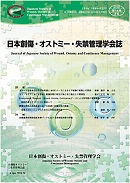Volume 17, Issue 4
Displaying 1-17 of 17 articles from this issue
- |<
- <
- 1
- >
- >|
Lecture
-
2014 Volume 17 Issue 4 Pages 225-227
Published: 2014
Released on J-STAGE: April 30, 2021
Download PDF (229K)
Lecture
-
2014 Volume 17 Issue 4 Pages 228-234
Published: 2014
Released on J-STAGE: April 30, 2021
Download PDF (3640K)
Lecture
-
2014 Volume 17 Issue 4 Pages 235-243
Published: 2014
Released on J-STAGE: April 30, 2021
Download PDF (11676K) -
2014 Volume 17 Issue 4 Pages 244-248
Published: 2014
Released on J-STAGE: April 30, 2021
Download PDF (1094K)
-
2014 Volume 17 Issue 4 Pages 249-254
Published: 2014
Released on J-STAGE: April 30, 2021
Download PDF (389K)
-
2014 Volume 17 Issue 4 Pages 255-256
Published: 2014
Released on J-STAGE: April 30, 2021
Download PDF (175K)
-
2014 Volume 17 Issue 4 Pages 257-263
Published: 2014
Released on J-STAGE: April 30, 2021
Download PDF (1034K) -
2014 Volume 17 Issue 4 Pages 264-271
Published: 2014
Released on J-STAGE: April 30, 2021
Download PDF (902K) -
2014 Volume 17 Issue 4 Pages 272-276
Published: 2014
Released on J-STAGE: April 30, 2021
Download PDF (744K)
-
2014 Volume 17 Issue 4 Pages 277-285
Published: 2014
Released on J-STAGE: April 30, 2021
Download PDF (382K)
Original Article
-
2014 Volume 17 Issue 4 Pages 286-293
Published: 2014
Released on J-STAGE: April 30, 2021
Download PDF (441K)
Report
-
2014 Volume 17 Issue 4 Pages 294-303
Published: 2014
Released on J-STAGE: April 30, 2021
Download PDF (528K) -
2014 Volume 17 Issue 4 Pages 304-311
Published: 2014
Released on J-STAGE: April 30, 2021
Download PDF (1835K)
Case Report
-
2014 Volume 17 Issue 4 Pages 312-314
Published: 2014
Released on J-STAGE: April 30, 2021
Download PDF (448K) -
2014 Volume 17 Issue 4 Pages 315-318
Published: 2014
Released on J-STAGE: April 30, 2021
Download PDF (258K)
Report
-
2014 Volume 17 Issue 4 Pages 319-335
Published: 2014
Released on J-STAGE: April 30, 2021
Download PDF (4720K)
Letter
-
2014 Volume 17 Issue 4 Pages 336-350
Published: 2014
Released on J-STAGE: April 30, 2021
Download PDF (4197K)
- |<
- <
- 1
- >
- >|
